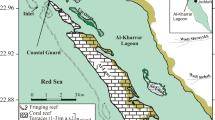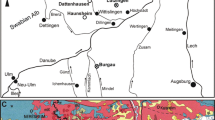Abstract
Sedimentological and micropaleontological characteristics of core sediments from the outer shelf of the Korea Strait, which connects the northern East China Sea and the East Sea (Sea of Japan), were investigated to elucidate the paleoceanographic environment, especially the timing of the Kuroshio inflow, since the last glacial maximum. The core sediments, containing continuous records of the last 15,000 years, are characterized by a relatively high mud content (more than 50%, on average) and well-developed tide-influenced sedimentary structures. Their mineralogy suggests that the material originated from the paleo-Nakdong River system, which extended across the shelf of the Korea Strait during low sea-level periods. Planktonic foraminifers reveal a series of well-defined changes in paleoceanographic conditions during the late Pleistocene–Holocene. Down-core variations in the abundance of four foraminiferal assemblages, i.e., cold, coastal, tropical–subtropical, and Kuroshio water groups comprising characteristic planktonic species, suggest the occurrence of a distinct paleoenvironmental change in the surface water at 7,000 years b.p., i.e., from 15,000 to 7,000 years b.p., the area was influenced by coastal waters whereas since ca. 7,000 years b.p., it has been under the influence of open-sea water related to the Kuroshio Current flow, associated with both higher temperature and higher salinity. In particular, Pulleniatina obliquiloculata increased markedly in abundance at this time, documenting the inflow of the Kuroshio into the study area. These data indicate that the coastal water stage terminated at ca. 7,000 years b.p. when the warm Kuroshio and its major branch, the Tsushima Current, began to flow into the East Sea, as is the case today. The intrusion of the Tsushima Current through the Korea Strait after ca. 7,000 years b.p. resulted in abrupt changes in sedimentation rates and a dramatic increase in abundance of the Kuroshio indicator species, P. obliquiloculata.






Similar content being viewed by others
References
Ahagon N, Tanaka Y, Ujiié H (1993) Florisphaera profunda, a possible nanoplankton indicator of late Quaternary changes in sea-water turbidity at the northwestern margin of the Pacific. Mar Micropaleontol 22:255–273
Bé AWH (1977) An ecological, zoo-geographical and taxonomic review of Recent planktonic foraminifera. In: Ramsay ATS (ed) Ocean micropaleontology, vol 1. Academic, London, pp 1–100
Folk RL, Ward WC (1957) Brazos river bar: a study in the significance of grain size parameters. J Sediment Petrol 27:3–26
Ijiri A, Wang L, Oba T, Kawahata H, Huang C-Y, Huang C-Y (2005) Paleoenvironmental changes in the northern area of the East China Sea during the past 42,000 years. Palaeogeogr Palaeoclimatol Palaeoecol 219:239–261
Jian Z, Wang P, Saito Y, Wang J, Pflaumann U, Oba T, Cheng X (2000) Holocene variability of the Kuroshio Current in the Okinawa Trough, northwestern Pacific Ocean. Earth Planet Sci Lett 184:305–319
Kawahata H, Ohshima H, Shimada C, Oba T (2003) Terrestrial–oceanic environmental change in the southern Okhotsk sea during the Holocene. Quat Int 108:67–76
Keigwin LD, Gobarenko SA (1992) Sea level, surface salinity of the Japan Sea, and the Younger Dryas Event in the northwestern Pacific Ocean. Quat Res 37:346–360
Kim J-M, Kennett JP (1998) Paleoenvironmental changes associated with the Holocene marine transgression, Yellow Sea (Hwanghae). Mar Micropaleontol 34:71–89
Kong GS, Park S-C, Han H-C, Chang JH, Mackensen A (2006) Late Quaternary paleoenvironmental changes in the southeastern Yellow Sea, Korea. Quat Int 144:38–52
Lee E, Nam S (2003) Freshwater supply by Korean rivers to the East Sea during the last glacial maximum: a review and new evidence from the Korea Strait region. Geo-Mar Lett 23:1–6
Li B, Jian Z, Wang P (1997) Pulleniatina obliquiloculata as a paleoceanographic indicator in the southern Okinawa Trough during the last 20,000 years. Mar Micropaleontol 32:59–69
Li B, Park B-K, Kim D (1999) Paleoceanographic records from the northern shelf of the East China Sea since the Last Glacial Maximum. J Korean Soc Oceanogr 34:151–166
Li T, Liu Z, Hall MA, Berne S, Saito Y, Cang S, Cheng Z (2001) Heinrich event imprints in the Okinawa Trough: evidence from oxygen isotope and planktonic foraminifera. Palaeogeogr Palaeoclimatol Palaeoecol 176:133–146
Lim DI, Park YA, Choi JY, Cho JW, Khim BK (2000) Glauconite grains in continental shelf sediments around the Korean Peninsula and their depositional implications. Geo-Mar Lett 20:80–86
Liu K, Sun S, Jinag X (1992) Environmental change in the Yangtze River Delta since 12 000 years B.P. Quat Res 38:32–42
Matsui H, Tada R, Oba T (1998) Low-salinity isolation event in the Japan Sea in response to eustatic sea-level drop during LGM: reconstruction based on salinity-balance model. Quat Res 37:221–233
Moore TC, Burckle LH, Geitzenauer K, Luz B, Molina-Cruz A, Robertson JH, Sachs H, Sancetta C, Thiede J, Thompson P, Wenkan C (1980) The reconstruction of sea surface temperature in the Pacific Ocean of 18,000 B.P. Mar Micropaleontol 5:147–215
Morley JJ, Heuser LE, Sarro T (1986) Latest Pleistocene and Holocene paleoenvironment of Japan and its marginal sea. Palaeogeogr Palaeoclimatol Palaeoecol 53:349–358
Oba T, Kato M, Kitazato H, Koizumi I, Omura A, Sakai T, Takayama T (1991) Paleoenvironmental changes in the Japan Sea during the last 85,000 years. Paleoceanography 6:499–518
Oda M, Takemoto A (1992) Planktonic foraminifera and paleoceanography in the domain of the Kuroshio Current around Japan during the last 20,000 years. Quat Res 31:341–357
Park SC, Yoo DG (1988) Depositional history of Quaternary sediments on the continental shelf off the southeastern coast of Korea (Korea Strait). Mar Geol 79:65–75
Park Y-A, Choi J-Y, Lee C-B, Kim D-C, Choi K-W (1994) Sediment distribution and depositional processes on the inner continental shelf off the west coast (middle part) of Korea. J Korea Soc Oceanogr 29:357–365
Park S-C, Yoo D-G, Lee C-W, Lee E-I (2000) Last glacial sea-level changes and paleogeography of the Korea (Tsushima) Strait. Geo-Mar Lett 20:64–71
Rohling EJ, Jorissen FJ, Grazzini CV, Zachariasse WJ (1993) Northern Levantine and Adriatic Quaternary planktic foraminifera; reconstruction of paleoenvironmental gradients. Mar Micropaleontol 21:191–218
Sawada K, Handa N (1998) Variability of the path of the Kuroshio Ocean current over the past 25 000 years. Nature 392:592–595
Stein R, Schubert C, Vogt C, Fterer D (1994) Stable isotope stratigraphy, sedimentation rates, and salinity changes in the latest Pleistocene to Holocene eastern central Arctic Ocean. Mar Geol 119:335–355
Tada R, Irino T (1999) Land–ocean linkages over orbital and millennial timescales recorded in late Quaternary sediments of the Japan Sea. Paleoceanography 14:236–247
Takemoto A, Oda M (1997) New planktic foraminiferal transfer functions for the Kuroshio–Oyashio Current region off Japan. Paleontol Res 1:291–310
Thompson PR (1981) Planktonic foraminifera in the western north Pacific during the past 150 000 years: comparison of modern and fossil assemblages. Palaeogeogr Palaeoclimatol Palaeoecol 35:241–279
Ujiié H, Ujiié Y (1999) Late Quaternary course changes of the Kuroshio Current in the Ryukyu Arc region, northwestern Pacific Ocean. Mar Micropaleontol 37:23–40
Ujiié Y, Ujiié YH (2000) Distribution and oceanographic relationships of modern planktonic foraminifera in the Ryukyu Arc region, northwest Pacific Ocean. J Foraminifer Res 30:336–360
Ujiié H, Tanaka Y, Ono T (1991) Late Quaternary paleoceanographic record from the middle Ryukyu Trench slope, northwest Pacific. Mar Micropaleontol 18:115–128
Ujiié Y, Ujiié H, Taira A, Nakamura T, Oguri K (2003) Spatial and temporal variability of surface water in the Kuroshio source region, Pacific Ocean, over the past 21,000 years: evidence from planktonic foraminifera. Mar Micropaleontol 49:335–364
Wang P, Zhang J, Min Q (1985) Distribution of foraminifera in surface sediments of the East China Sea. In: Wang P (ed) Marine micropaleontology of China. China Ocean Press, Beijing, pp 34–69
Wang P, Zhang L, Zhao Q, Min Q, Bian Y, Zheng L, Cheng X, Chen R (1988) Foraminifera and Ostracoda in bottom sediments of the East China Sea. Ocean Press, Beijing
Watkins JM, Mix AC, Wilson J (1998) Living planktic foraminifera in the central tropical Pacific Ocean: articulating the equatorial ‘cold tongue’ during La Niña, 1992. Mar Micropaleontol 33:157–174
Xu X, Oda M (1999) Surface-water evolution of the eastern East China Sea during the last 36,000 years. Mar Geol 156:285–304
Acknowledgements
The authors are grateful to K.C. Rho, Korea Ocean Research and Development Institute, who kindly assisted with the laboratory work. The review comments of two anonymous referees greatly helped in sharpening the manuscript. This study was supported by a KORDI research program (grant no. PM37500 and PP06401) in Korea.
Author information
Authors and Affiliations
Corresponding author
Rights and permissions
About this article
Cite this article
Lim, D.I., Kang, S., Yoo, H.S. et al. Late Quaternary sediments on the outer shelf of the Korea Strait and their paleoceanographic implications. Geo-Mar Lett 26, 287–296 (2006). https://doi.org/10.1007/s00367-006-0039-x
Received:
Accepted:
Published:
Issue Date:
DOI: https://doi.org/10.1007/s00367-006-0039-x




